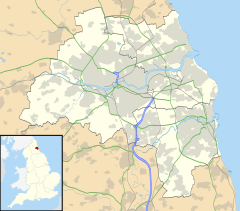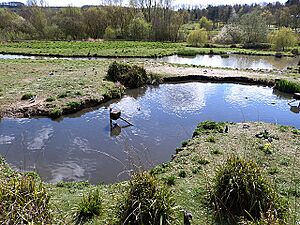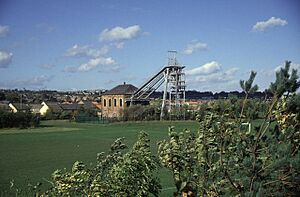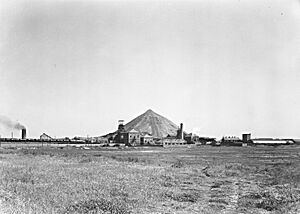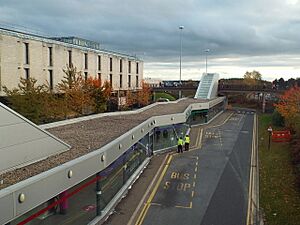Washington, Tyne and Wear facts for kids
Quick facts for kids Washington |
|
|---|---|
| Town | |
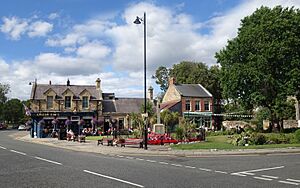 The old Washington village green |
|
| Population | 67,085 |
| OS grid reference | NZ3157 |
| Metropolitan borough | |
| Metropolitan county | |
| Region | |
| Country | England |
| Sovereign state | United Kingdom |
| Post town | WASHINGTON |
| Postcode district | NE37, NE38 |
| Dialling code | 0191 |
| Police | Northumbria |
| Fire | Tyne and Wear |
| Ambulance | North East |
| EU Parliament | North East England |
| UK Parliament |
|
Washington is a town in the Sunderland area, located in Tyne and Wear, England. It used to be part of County Durham. This town is famous as the original home of the Washington family. The first President of the United States, George Washington, came from this family! Today, about 67,085 people live here.
Washington is found between Chester-le-Street, Gateshead, and South Tyneside. In 1964, it was chosen to be a "new town". This meant it would be planned and built to help people find homes and jobs. In 1974, it became part of Tyne and Wear. Since then, Washington has grown a lot. New villages were built, and some areas from Chester-le-Street were added to the town. This helped more people move in and find work. By 2011, Washington's population had grown to 67,085 from 53,388 in 2001.
Contents
History of Washington
How Washington Got Its Name
The name "Washington" has been around for a long time, first appearing as "Wasindone" around 1096. No one is completely sure how the name came to be, but there are a few ideas.
The Hwæsa Theory
The most popular idea, especially among local historians, is that "Washington" comes from an old Anglo-Saxon name: Hwæsingatūn. This basically means "the estate of Hwæsa's family." Hwæsa was likely the name of an important person, like a leader or farmer, from a very long time ago.
Let's break down Hwæsingatūn:
- "Hwæsa" – This was probably a person's name.
- "ing" – This old word meant "descended from" or "belonging to."
- "tūn" – This is where our modern word "town" comes from. It meant a "fenced-off estate" or a place with clear borders.
So, putting it all together, Hwæsingatūn meant "the estate of Hwæsa's descendants." Even though this theory is popular, no old records have been found that mention a person named Hwæsa in the area.
The "Washing" Theory
Another idea is that "Washington" came from the Old English words wascan (to wash) and dūn (hill). This would mean "washing hill." People thought this because the River Wear was close to where the old Anglo-Saxon hall stood (where Washington Old Hall is today).
However, experts say this idea isn't quite right. If you combine "wascan" and "dūn" in Old English, it would mean "washed hill," not "washing hill." Also, "dūn" usually meant gentle, rolling hills, like the North Downs and South Downs in southern England.
The Old Hall
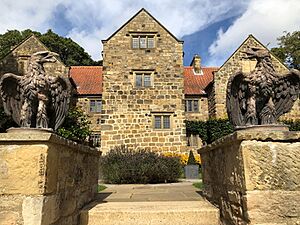
The Old Hall might have been built by a man named William de Hertburn. He moved to the area in 1183 and, as was common then, took the name of his new land, becoming William de Wessyngton. By 1539, when his family moved to Sulgrave Manor, the name was spelled "Washington."
The building you see today is an early 17th-century manor house made of sandstone. Only the very old foundations and some arches from the original house remain.
George Washington's Family Connection
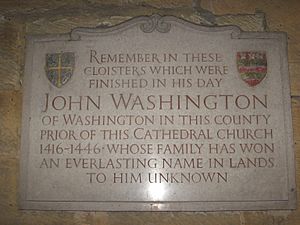
William de Wessyngton was an ancestor of George Washington, who became the first president of the United States. Many places in the US, like the capital city and a state, are named after him. Even though George Washington's great-grandfather, John Washington, left England from Northamptonshire, Washington Old Hall was the family home of his ancestors.
The current Old Hall still has small parts of the medieval house where they lived. Every year, on American Independence Day, a special ceremony is held at Washington Old Hall to celebrate this connection.
Dame Margaret's Hall
Sir Isaac Lowthian Bell and his wife Margaret lived in Washington New Hall. After Margaret passed away in 1871, Sir Isaac turned their home into an orphanage. He named it Dame Margaret Home in her honor. It later became a Dr Barnardo's children's home until World War II. After the war, it was used as a training center and then became a children's home again. Today, it has been turned into private apartments.
Building the New Town
Washington was designed as a "New Town" to help it grow in a good way. The town is split into 18 "villages" where people live. It used to be divided into 15 numbered districts, which often confused visitors. These numbered districts were stopped in 1983, though you might have seen them on old road signs or addresses for a while.
Land in the southwest of the town was bought from the Lambton family, who were the Earls of Durham. Their estate includes their family home, Lambton Castle.
In 1970, Washington hosted a big sports event for English schools. In 1977, the very first SavaCentre supermarket opened at The Galleries. This was a joint project between Sainsbury's and British Home Stores. By 2005, it became a regular Sainsbury's store.
Geography of Washington
Washington is made up of several villages. Some of these villages were ancient townships. The villages include:
- Albany
- Ayton
- Barmston
- Biddick
- Blackfell
- Columbia
- Concord
- Donwell
- Fatfield
- Glebe
- Harraton
- Lambton
- Mount Pleasant
- Oxclose
- Rickleton
- Sulgrave
- Usworth
- Washington Village (this is the original old village where the Old Hall is).
The town also has ten industrial areas. Some of these are named after famous engineers from the north of England, like Parsons and Stephenson.
Community and Culture
Washington is home to the Wildfowl and Wetlands Trust nature reserve, which is a great place to see birds and wildlife. You can also visit The Washington 'F' Pit mining museum, which tells the story of coal mining.
The Washington Arts Centre is a building that used to be a farm. Now it has an art gallery, a community theater, artist studios, and even a recording studio. The North East Land, Sea and Air Museums is just north of the old RAF Usworth air base. The Nissan car plant takes up a large area nearby. The airport that used to be there closed in 1984 to make way for the Nissan factory.
Industry
In the past, Washington was very important for the coal industry, with many coal mines. One of these, the 'F' Pit in the Albany area, is now a museum. Many of Washington's old communities grew up around these mines. To move the coal, there were special tracks called wagonways, and later railway lines. These took coal to the River Wear, where it could be loaded onto boats and sent to ships in Sunderland.
Washington also had a big chemical industry. The Washington Chemical Works was a major employer in the 1800s. This company later became Cape/Newalls Works, which made insulation. The Pattinson Town area of Washington grew around this chemical factory. Today, this area is an industrial estate and a housing area.
Now, Washington's main industries include electronics, car making, chemicals, and electrical goods. There are also government offices in the Town Centre. The Nissan car plant is the biggest car factory in Britain and the largest private employer in Sunderland.
The Goodyear Tire and Rubber Company, a big American tire company, opened a factory in Washington in 1968. This factory later became Dunlop and Sumitomo Tyres. However, it closed in 2006, meaning 585 people lost their jobs. Now, Rolls-Royce Holdings makes airplane engine parts there, and British Aerospace also has a presence.
Education
Washington has many schools and colleges for students of all ages.
Primary Schools
- Albany Village Primary
- Barmston Village Primary
- Biddick Primary School
- Columbia Grange School
- Fatfield Primary School
- George Washington School
- Holley Park Primary School
- John F. Kennedy Primary School
- Lambton Primary School
- Oxclose Primary
- Rickleton Primary School
- St Bedes Primary School
- St John Boste RC Primary School
- St Joseph's Roman Catholic Primary School
- Usworth Colliery
- Marlborough Park
- Wessington Primary
Secondary Schools
- Biddick Academy
- Oxclose Community Academy
- St Robert of Newminster Catholic School
- Washington Academy
Colleges
- St Robert of Newminster Sixth Form
- City of Sunderland College Usworth
Other Education
The North East of England Japanese Saturday School, which helps Japanese children keep up with their home country's curriculum, used to hold classes at Oxclose Community School.
Sport
Washington F.C. is a local football club that plays in the Northern League Division Two.
In 2005, the Washington R.F.C. (rugby football club) was started. They currently play in the Durham and Northumberland Division 3.
Transport
Washington has a main bus station at The Galleries, and another one at Concord. The main bus company, Go North East, provides local services and connections to bigger cities like Newcastle upon Tyne and Sunderland.
Major roads run through Washington, including the A182, the A1231 (Sunderland Highway), and the A195. All these roads connect to the A1(M) motorway, which is on the western side of Washington. There's also a Travelodge hotel at Washington Services, located near the A1(M).
The town's old Washington closed to passengers in the 1960s. The railway line it was on is no longer used, but parts of it are now footpaths. There are plans to potentially extend the Tyne and Wear Metro to Washington in the future, which would bring train services back to the town.
Notable People
- Gertrude Bell, a famous writer and explorer, was born at Washington Hall.
- Bryan Ferry, a musician from the band Roxy Music, grew up in Washington and went to Washington Grammar School.
- Heather Mills, known for marrying Paul McCartney, went to primary and comprehensive schools in Washington.
- Toni Halliday, a musician from the band Curve, also went to Washington School.
- Billy Furness, a footballer who played for Leeds United and the England team, was born in Washington.
- Jordan Pickford, the goalkeeper for Sunderland, Everton, and England, grew up in Washington.
- George Clarke, an architect and TV presenter, was brought up in Washington.
See also
 In Spanish: Washington (Tyne y Wear) para niños
In Spanish: Washington (Tyne y Wear) para niños


